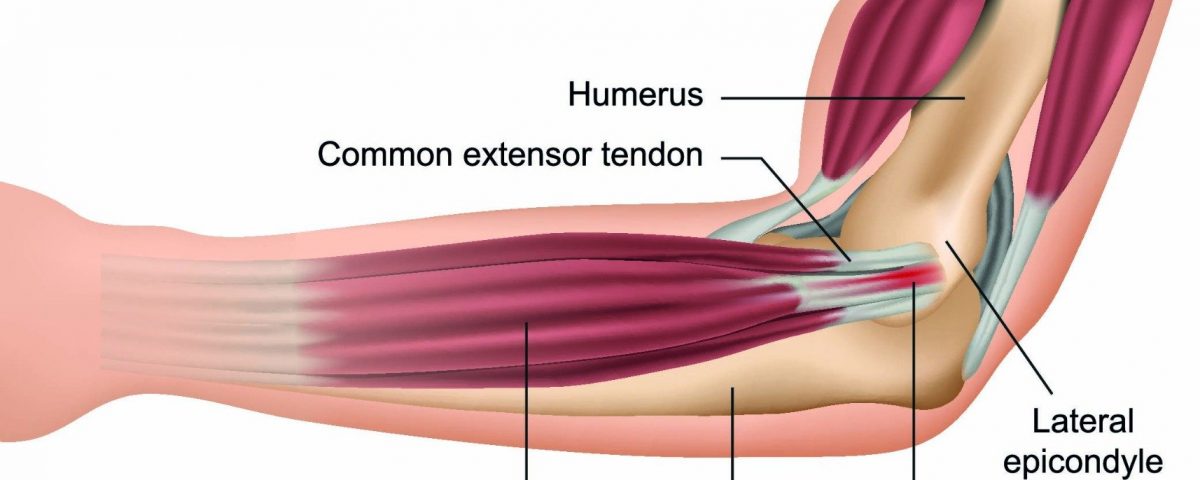
Acute Tennis Elbow is an injury to the muscles that extend the wrist and fingers. The site of injury is typically the lateral epicondyle, a bony bump on the outside of the elbow where these muscles attach.
Tennis Elbow symptoms that have lasted more than 6 weeks are considered to be sub-acute and beyond three months, as chronic tennis elbow.
Symptoms of Tennis Elbow
Typically the Tennis Elbow sufferer will experience pain while performing gripping tasks or resisted wrist/finger extension. Pain can also be present when the muscles are stretched. There will be tenderness directly over the bony epicondyle, and there may be trigger points in the wrist muscles.
Some sufferers will also have neck stiffness and tenderness, as well as signs of nerve irritation. Most elbow movements will be pain-free, despite that being the area of pain.
Causes of Acute Tennis Elbow?
Acute Tennis Elbow is caused by damaged muscle tissue at the point it anchors to the arm bone at the elbow. It occurs when more force is applied to an area than the normal healthy tissues can handle.
Common Tennis Elbow Causes include:
Unaccustomed hand use like painting a fence, hammering, lots of typing.
Excessive gripping or wringing activities
Poor forearm muscle strength or tight muscles
Poor technique (this may be a poor tennis shot)
In some cases such as Chronic Tennis Elbow, this can occur due to the soft tissues being in poor health, which are easily injured. Inflammation follows the injury, which leads to swelling and elbow pain.
What Causes Chronic Tennis Elbow?
Chronic Tennis Elbow is associated with degenerative changes in the muscle tissues located at the epicondyle. Although for a long time this was thought to be related to inflammation from overuse, this is now known to be incorrect.
Chronic Tennis Elbow is NOT due to INFLAMMATION!
Testing of Chronic Tennis Elbow sufferers has shown no evidence of the chemicals normally associated with inflammation. Instead, there is an increase in chemicals associated with pain transmission in the nerves. This is coupled with changes in the blood supply, and changes in the coordination of the muscles when using the hand and wrist. You also see degenerative changes in the extensor tendon, where the tendon structure starts to break down.
There is also evidence that longstanding forearm muscle imbalances can distort your elbow joint position and result in chronic tennis elbow pain. This results in decreased ability to perform normal elbow activities and reducing elbow and grip strength.
How is Tennis Elbow Diagnosed?
Your Tennis Elbow is clinically diagnosed by your physiotherapist. After listening to your injury history and using some confirmatory clinical tests a provisional diagnosis of tennis elbow can be made.
An ultrasound scan or MRI are the best tests to identify any tendon tears or inflammation. X-rays are of little diagnostic benefit.
Referred Pain from your Neck can mimic Tennis Elbow
A significant percentage of tennis elbow sufferers may feel pain in the lateral elbow, but not actually be experiencing tennis elbow. There is a high incidence of lateral elbow pain that is referred to your elbow from a cervical spine (neck) injury.
The most common neck joint that refers to your lateral elbow is C56, which transmit their pain signals along the radial nerve.
Your radial nerve may also have reduced neural mobility, which can cause symptoms similar to tennis elbow.
It is extremely important to have your neck and upper limb neurodynamics assessed by an experienced physical therapist to confirm or exclude any neck dysfunction or neural tension. Failure to do so, will result in a lack of symptom improvement and the development of chronic tennis elbow pain syndrome.